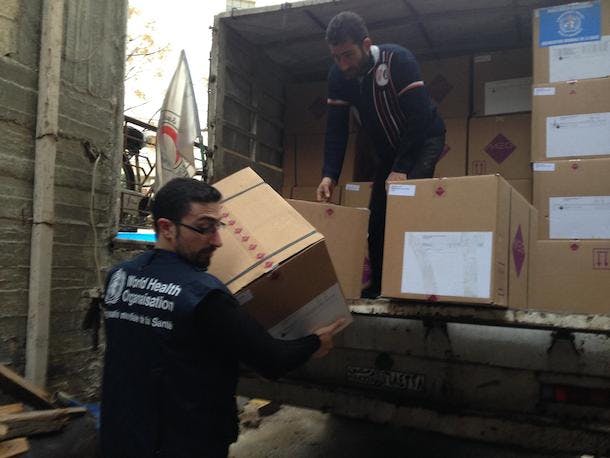 WHO/T. Jasarevic
WHO/T. Jasarevic
Amal is a five-year-old Syrian girl who loved having tea parties with her cousins. In 2013, she was diagnosed with cancer – a tumor in the nervous system – and is being treated at the Children Hospital in Damascus.
The crisis in Syria, which enters its fifth year this month, has devastated Syria’s health system and led to severe shortages in treatments for ailments from heart disease to cancer.
“It is really disturbing to see how this conflict is continuing and negatively affecting people’s lives from every corner,” said Elizabeth Hoff, the World Health Organization (WHO) Representative in Syria. “We are trying the best we can to meet the needs.”
WHO has helped provide cancer medicines to hospitals in Syria so other children like Amal can get the care they need – one element of the aid WHO and partners are providing to Syrians in need.
The United Nations Foundation recently spoke with the World Health Representative in Syria about the challenges facing Syrians in need, what WHO is doing to alleviate the impact of the crisis on the populations in need, and how individuals can support those efforts. Here are some of the key takeaways from the conversation:
CHALLENGES
The difficulties for health care services delivery in Syria include:
- Lack of access to health services and treatments: 57% of public hospitals are either partially functioning or completely out of service; 63% of public basic emergency obstetric care centers are not functioning; and limited health services mean some patients have to travel up to 160 km to reach the nearest hospital.
- Lack of clean water: Over 50% of the population does not have access to safe drinking water, and 90% of wastewater goes untreated into rivers and waterways.
- Injury: More than 1 million Syrians have been injured by the conflict, including children.
- Disease: Vaccination coverage has dropped significantly to 55% in 2014, and Syria has had measles, pertussis, and polio outbreaks.
PROVIDING LIFE-SAVING AID
As the crisis continues, WHO – along with other UN agencies and humanitarian partners – continues to provide aid to those in need. WHO’s work includes:
- Providing medicines, equipment, and supplies: In 2014, WHO delivered medicines and supplies to reach over 13.8 million people, with almost one-third delivered to hard-to-reach and opposition-controlled areas.
- Capacity building: WHO trained over 17,000 health care providers in areas ranging from trauma care and first aid to mental health care and detecting malnutrition in order to support and strengthen the health care system.
- Building herd immunity among children: In 2013, polio reappeared in Syria and the country has also experienced outbreaks of measles and pertussis. To protect children, WHO, UNICEF, and other partners have vaccinated 2.9 million children against polio. As a result, it has been over a year since the last case of polio was reported in the country. Approximately, 1.1 children were also vaccinated against measles. WHO has also provided technical support to improve routine immunization.
- Partnering with non-governmental groups to expand care: WHO has partnered with 56 NGOs throughout the country to expand humanitarian relief efforts. These strategic partnerships with local NGOs facilitated access to health services for 3 million people in 2014 including those in hard-to-reach areas.
HOW YOU CAN HELP
The humanitarian response in Syria continues to be severely underfunded. WHO needs resources and support to provide aid to people in need.
Each of us can help raise awareness, share information, and advocate for these resources. As Hoff said, “Everybody has a role to play.”
*Rebecca Davis contributed to this post.



 View All Blog Posts
View All Blog Posts